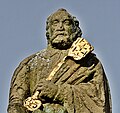Petrusbrunnen (Brilon)
The Petrusbrunnen , colloquially Kump , is a listed fountain in Brilon in the Sauerland .
history
The fountain was first mentioned in a document in 1360. It was the central point of the water supply. With the help of hand-drilled wooden pipes, the water was directed from a never-ending spring from Poppenberg into the city. Even in dry seasons, when the other springs and wells in the city dried up, the population could get drinking water here. The Minorite Monastery reported in a chronicle in 1776: “There was a great drought and lack of water, all wells were dry; our convent also had to fetch water from the Vorderbeck fountain and after this has also been exhausted, we still have to have it brought in from the market fountain today. "According to an official report, the fountain was the only drinking water scoop in the city until 1819, the natural spring water in applied in abundance and with natural pressure. Outside of dry periods, the water flowed so abundantly that cattle could also be watered with the overflowing part. In addition to this, some farmers dug private wells of varying depth and productivity. A failure of the water supply is reported only once: In 1822 it was so unusually cold that the Kump froze over and the water was fetched from the Aa . In the first half of the 19th century, various iron water pipes were laid from the Kump to improve the water supply. In the second half of the 19th century, these were gradually replaced by more modern water supply and, as a result, canalization.
description
The fountain got its present form in 1726 when the fountain bowl was renewed. It consists of 23 sandstone slabs . The remains of coats of arms can still be seen on it. There are coats of arms of long-established Brilon bourgeois families who are particularly committed to the maintenance and care of the fountain. In the middle of the fountain bowl stands the life-size statue of the Apostle Peter on a multi-tiered column . The figure comes from a previous fountain from the first half of the 16th century; she directs her gaze to the historic town hall and the provost church .
At the end of the Briloner Schnade, the Schnadezug festively pulls into the city under the ringing of all church bells. Traditionally, the train pulls around the kump three times.
Detailed views
literature
- Dorothea Kluge, Wilfried Hansmann: North Rhine-Westphalia . tape 2 , Westphalia . Deutscher Kunstverlag, Munich 1969, DNB 450887766 , OCLC 272521926 (Handbook of German Art Monuments).
- Magnus Müller, Theodor Tochtrop: 750 years of the city of Brilon from 1220 to 1970 . Ed .: City of Brilon. Brilon 1970, DNB 730507378 , p. 14 .
Web links
Individual evidence
- ^ Dorothea Kluge, Wilfried Hansmann: North Rhine-Westphalia . Westphalia. tape 2 . Deutscher Kunstverlag, Munich 1969, DNB 450887766 , OCLC 272521926 , p. 421 (Handbook of German Art Monuments).
Coordinates: 51 ° 23 ′ 44.4 " N , 8 ° 34 ′ 4" E





